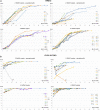Newborn screening for spinal muscular atrophy in Germany: clinical results after 2 years
- PMID: 33789695
- PMCID: PMC8011100
- DOI: 10.1186/s13023-021-01783-8
Newborn screening for spinal muscular atrophy in Germany: clinical results after 2 years
Abstract
Background: Spinal muscular atrophy (SMA) is the most common neurodegenerative disease in childhood. Since motor neuron injury is usually not reversible, early diagnosis and treatment are essential to prevent major disability. Our objective was to assess the impact of genetic newborn screening for SMA on outcome.
Methods: We provided clinical data from 43 SMA patients, identified via polymerase chain reaction of the SMN1 gene from dried blood spots between January 2018 and January 2020 in Germany. Follow-up included neurophysiological examinations and standardized physiotherapeutic testing.
Results: Detection of SMA with newborn screening was consistent with known incidence in Germany. Birth prevalence was 1:6910; 39.5% had 2 SMN2 copies, 23% had 3 SMN2 copies, 32.5% had 4 copies, and 4.5% had 5 copies of the SMN2 gene. Treatment with SMA-specific medication could be started at the age of 14-39 days in 21 patients. Pre-symptomatically treated patients remained throughout asymptomatic within the observation period. 47% of patients with 2 SMN2 copies showed early, presumably intrauterine onset of disease. These patients reached motor milestones with delay; none of them developed respiratory symptoms. Untreated children with 2 SMN2 copies died. Untreated children with 3 SMN2 copies developed proximal weakness in their first year. In patients with ≥ 4 SMN2 copies, a follow-up strategy of "watchful waiting" was applied despite the fact that one of them was treated from the age of 6 months. Two infant siblings with 4 SMN2 copies were identified with a missed diagnosis of SMA type 3.
Conclusion: Identification of newborns with infantile SMA and prompt SMA-specific treatment substantially improves neurodevelopmental outcome, and we recommend implementation in the public newborn screening in countries where therapy is available. Electrophysiology is a relevant parameter to support the urgency of therapy. There has to be a short time interval between a positive screening result and referral to a therapy-ready specialized treatment center.
Conflict of interest statement
All authors have indicated that they don’t have any non-financial conflicts of interest. Financial Disclosure: Astrid Blaschek, Bernhard Olgemöller, Erik Harms, Katja Eggermann and Uta Nennstiel have nothing to disclose. Marc Becker is the owner of a commercial entity (Laboratory Becker and colleagues MVZ GbR, Führichstraße 70, 81871 Munich, Germany). Siegfried Burggraf, Wulf Röschinger, Jürgen Durner, Ludwig Czibere are employed at a commercial entity (Laboratory Becker and colleagues MVZ GbR, Führichstraße 70, 81871 Munich, Germany). Dieter Gläser is the co-owner of a commercial entity (Genetikum®, Wegenerstr. 15, 89231 Neu-Ulm, Germany). Katharina Vill has received travel expenses and speaker fees from Biogen. Oliver Schwartz has served as a member of a scientific advisory board for Avexis and received travel expenses and speaker fees from Biogen. Heike Kölbel has served as a member of a scientific advisory board for Avexis and received travel expenses and speaker fees from Biogen and Sanofi-Aventis. Ulrika Schara has served as a member of a scientific advisory board and data safety monitoring board for Biogen, Avexis and Novartis and received speaker fees from Biogen, Avexis, PTC and Sanofi-Aventis. Brunhilde Wirth has served as a member of a scientific advisory board and data safety monitoring board for SMA Europe and received travel expenses and speaker fees from Biogen. Wolfgang Müller-Felber has served as a member of a scientific advisory board for Biogen, Avexis, PTC, Sanofi-Aventis, Roche and Cytokinetics and received travel expenses and speaker fees from Biogen, Avexis, PTC and Sanofi-Aventis.
Figures



References
-
- Wirth B, Karakaya M, Kye MJ, Mendoza-Ferreira N. Twenty-Five Years of Spinal Muscular Atrophy Research: From Phenotype to Genotype to Therapy, and What Comes Next. Annu Rev Genomics Hum Genet 2020. - PubMed
Publication types
MeSH terms
Substances
LinkOut - more resources
Full Text Sources
Other Literature Sources
Medical

